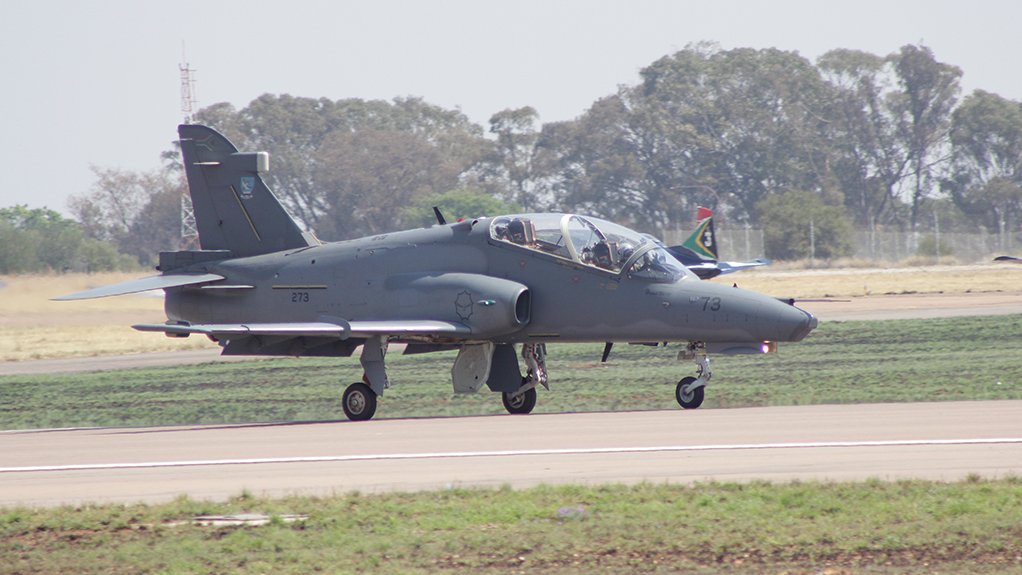Successful Anglo-Australian project could greatly extend life of SAAF Hawk jets


A Hawk Mk 120 of the SAAF taxiing during an air show at Air Force Base Waterkloof
Photo by Creamer Media
In a major development that could be very beneficial for the South African Air Force (SAAF), UK-based global major aerospace and defence group BAE Systems (BAES) announced on Monday that, in a joint project with Australia’s Defence Science and Technology Organisation (DSTO), it had massively extended the safe flying life for late-generation Hawk lead-in fighter-trainers. The Royal Australian Air Force (RAAF) operates the Hawk Mark (Mk) 127, which BAES describes as the most advanced standard of the Hawk.
The Hawk Mk 127 was designed for a safe flying life of at least 10 000 hours, but a combined BAES/DSTO major structural test programme on a specially modified example has extended this to 50 000 flying hours. This means that the RAAF will be able to operate its Hawks for decades to come. The company pointed out that the air forces of Oman, Saudi Arabia and the UK operated Hawks of similar standards to those of the RAAF, and that new Hawks of this advanced standard were currently being manufactured for Qatar.
“To achieve 50 000 flying hours in structural testing is five times the current clearance of the most modern Hawk in air forces across the world and more than ten times the current flying hours on most of the Australian fleet,” reported BAES International Markets head Mike Swales. “Hawk has been the world’s flying classroom, preparing more than 20 000 pilots for life in a frontline fast jet, for decades and this is proof that it has many years more safe, effective flying ahead of it with customers set to operate the aircraft well into the 2040s.”
The test programme was actually launched in February 2006 and concluded in June this year and was conducted at the DSTO’s facility in Melbourne in the Australian state of Victoria, supported by BAES engineers in Brough in the UK. The aircraft used in the programme will be disassembled and its components will be subjected to another two years of in-depth inspections.
“This is a major milestone for the Hawk programme which proves there is many years more life left in the 650 aircraft we have training pilots across the globe every day,” he highlighted. The RAAF’s Hawk Mk 127 is a ‘second-generation’ development of the aircraft. The SAAF operates the Hawk Mk 120, which is also a second-generation Hawk model. This, plus Swales' comment, suggests that this operational life-extension could be applied to SAAF Hawks as well.
The SAAF acquired 24 Hawk Mk 120s. These are currently operated by 85 Combat Flying School at Air Force Base Makhado in Limpopo province.
Comments
Announcements
What's On
Subscribe to improve your user experience...
Option 1 (equivalent of R125 a month):
Receive a weekly copy of Creamer Media's Engineering News & Mining Weekly magazine
(print copy for those in South Africa and e-magazine for those outside of South Africa)
Receive daily email newsletters
Access to full search results
Access archive of magazine back copies
Access to Projects in Progress
Access to ONE Research Report of your choice in PDF format
Option 2 (equivalent of R375 a month):
All benefits from Option 1
PLUS
Access to Creamer Media's Research Channel Africa for ALL Research Reports, in PDF format, on various industrial and mining sectors
including Electricity; Water; Energy Transition; Hydrogen; Roads, Rail and Ports; Coal; Gold; Platinum; Battery Metals; etc.
Already a subscriber?
Forgotten your password?
Receive weekly copy of Creamer Media's Engineering News & Mining Weekly magazine (print copy for those in South Africa and e-magazine for those outside of South Africa)
➕
Recieve daily email newsletters
➕
Access to full search results
➕
Access archive of magazine back copies
➕
Access to Projects in Progress
➕
Access to ONE Research Report of your choice in PDF format
RESEARCH CHANNEL AFRICA
R4500 (equivalent of R375 a month)
SUBSCRIBEAll benefits from Option 1
➕
Access to Creamer Media's Research Channel Africa for ALL Research Reports on various industrial and mining sectors, in PDF format, including on:
Electricity
➕
Water
➕
Energy Transition
➕
Hydrogen
➕
Roads, Rail and Ports
➕
Coal
➕
Gold
➕
Platinum
➕
Battery Metals
➕
etc.
Receive all benefits from Option 1 or Option 2 delivered to numerous people at your company
➕
Multiple User names and Passwords for simultaneous log-ins
➕
Intranet integration access to all in your organisation



















